Electric boat: Difference between revisions
Wtshymanski (talk | contribs) add "a"' wordy |
Rescuing 3 sources and tagging 0 as dead. #IABot (v1.5.2) |
||
| Line 25: | Line 25: | ||
[[File:Early electric launch.jpg|thumb|right|260x260px|Early electric launch on the [[River Thames]], built by William Sargeant.]] |
[[File:Early electric launch.jpg|thumb|right|260x260px|Early electric launch on the [[River Thames]], built by William Sargeant.]] |
||
The company's electric launches were widely used by the rich as a conveyance along the river. Grand ships were constructed of teak or mahogany and furnished luxuriously, with stained glass windows, silk curtains and velvet cushions. William Sargeant was commissioned by Immisch's company to build the ''Mary Gordon'' in 1898 for [[Leeds City Council]] for use on the [[Roundhay Park]] Lake - the boat still survives and is currently being restored.<ref>{{cite web|url=http://www.marygordon.org.uk/marygordon.htm |title=Mary Gordon Electric River Boat |accessdate=31 May 2010 |deadurl=yes |archiveurl=https://web.archive.org/web/20100607094901/http://www.marygordon.org.uk |
The company's electric launches were widely used by the rich as a conveyance along the river. Grand ships were constructed of teak or mahogany and furnished luxuriously, with stained glass windows, silk curtains and velvet cushions. William Sargeant was commissioned by Immisch's company to build the ''Mary Gordon'' in 1898 for [[Leeds City Council]] for use on the [[Roundhay Park]] Lake - the boat still survives and is currently being restored.<ref>{{cite web |url=http://www.marygordon.org.uk/marygordon.htm |title=Mary Gordon Electric River Boat |accessdate=31 May 2010 |deadurl=yes |archiveurl=https://web.archive.org/web/20100607094901/http://www.marygordon.org.uk/marygordon.htm |archivedate=7 June 2010 |df=dmy }}</ref> This 70 foot long luxury pleasure craft could carry up to 75 passengers in comfort. Launches were exported elsewhere - they were used in the [[Lake District]] and all over the world. |
||
In the 1893 [[World's Columbian Exposition|Chicago World Fair]] 55 launches developed from [[Anthony Reckenzaun]]'s work carried more than a million passengers.<ref>{{cite web|url=http://sunboat.com/history/history.html|title=The story of solar powered boats|accessdate=31 May 2010}}</ref><ref>{{cite web|title=History of our Classic Motor Yachts|url=http://www.elcomotoryachts.com/history.shtml|publisher=Elco|accessdate=21 February 2011}}</ref> Electric boats had an early period of popularity between around 1890 and 1920, before the emergence of the internal combustion engine drove them out of most applications. |
In the 1893 [[World's Columbian Exposition|Chicago World Fair]] 55 launches developed from [[Anthony Reckenzaun]]'s work carried more than a million passengers.<ref>{{cite web|url=http://sunboat.com/history/history.html|title=The story of solar powered boats|accessdate=31 May 2010}}</ref><ref>{{cite web|title=History of our Classic Motor Yachts|url=http://www.elcomotoryachts.com/history.shtml|publisher=Elco|accessdate=21 February 2011}}</ref> Electric boats had an early period of popularity between around 1890 and 1920, before the emergence of the internal combustion engine drove them out of most applications. |
||
| Line 33: | Line 33: | ||
===Decline=== |
===Decline=== |
||
[[File:Koenigssee Schoenau-Anlegepier.jpg|thumb|right|An electric passenger launch on Lake Königssee in Germany]] |
[[File:Koenigssee Schoenau-Anlegepier.jpg|thumb|right|An electric passenger launch on Lake Königssee in Germany]] |
||
With the advent of the gasoline-powered [[outboard motor]], the use of electric power on boats declined from the 1920s. However, in a few situations, the use of electric boats has persisted from the early 20th century to the present day. One of these is on the [[Königssee]] lake, near [[Berchtesgaden]] in south-eastern [[Germany]]. Here the lake is considered so environmentally sensitive that steam and motor boats have been prohibited since 1909. Instead the [[Bayerische Seenschifffahrt]] company and its predecessors have operated a fleet of electric launches to provide a public passenger service on the lake.<ref>{{cite web | url = http://www.behoerdenwegweiser.bayern.de/dokumente/aufgabenbeschreibung/76666130115 | title = Bayerische Seenschifffahrt GmbH | language = German | trans_title = Bavarian Lakes Maritime Ltd. | publisher = Bavarian State Ministry of the Interior | accessdate = 11 July 2011}}</ref><ref>{{cite web|url=http://www.seenschifffahrt.de/de/unternehmen/geschichte.asp |title=Geschichtliche Hintergründe |language=German |trans_title=Historical Background |publisher=Bayerische Seenschifffahrt |accessdate=11 July 2011 |deadurl=yes |archiveurl=https://web.archive.org/web/20111210004130/http://www.seenschifffahrt.de/de/unternehmen/geschichte.asp |archivedate=10 December 2011 |df=dmy }}</ref><ref>[http://www.siemens.com/innovation/en/home/pictures-of-the-future/mobility-and-motors/electric-mobility-quiet-cruising-on-koenigssee.html Quiet Cruising on Königssee] [https://web.archive.org/web/20141021033011/http://www.siemens.com/innovation/en/home/pictures-of-the-future/mobility-and-motors/electric-mobility-quiet-cruising-on-koenigssee.html Archive]</ref> |
With the advent of the gasoline-powered [[outboard motor]], the use of electric power on boats declined from the 1920s. However, in a few situations, the use of electric boats has persisted from the early 20th century to the present day. One of these is on the [[Königssee]] lake, near [[Berchtesgaden]] in south-eastern [[Germany]]. Here the lake is considered so environmentally sensitive that steam and motor boats have been prohibited since 1909. Instead the [[Bayerische Seenschifffahrt]] company and its predecessors have operated a fleet of electric launches to provide a public passenger service on the lake.<ref>{{cite web | url = http://www.behoerdenwegweiser.bayern.de/dokumente/aufgabenbeschreibung/76666130115 | title = Bayerische Seenschifffahrt GmbH | language = German | trans_title = Bavarian Lakes Maritime Ltd. | publisher = Bavarian State Ministry of the Interior | accessdate = 11 July 2011 | deadurl = yes | archiveurl = https://web.archive.org/web/20110929074446/http://www.behoerdenwegweiser.bayern.de/dokumente/aufgabenbeschreibung/76666130115 | archivedate = 29 September 2011 | df = dmy-all }}</ref><ref>{{cite web|url=http://www.seenschifffahrt.de/de/unternehmen/geschichte.asp |title=Geschichtliche Hintergründe |language=German |trans_title=Historical Background |publisher=Bayerische Seenschifffahrt |accessdate=11 July 2011 |deadurl=yes |archiveurl=https://web.archive.org/web/20111210004130/http://www.seenschifffahrt.de/de/unternehmen/geschichte.asp |archivedate=10 December 2011 |df=dmy }}</ref><ref>[http://www.siemens.com/innovation/en/home/pictures-of-the-future/mobility-and-motors/electric-mobility-quiet-cruising-on-koenigssee.html Quiet Cruising on Königssee] [https://web.archive.org/web/20141021033011/http://www.siemens.com/innovation/en/home/pictures-of-the-future/mobility-and-motors/electric-mobility-quiet-cruising-on-koenigssee.html Archive]</ref> |
||
The first electrically powered submarines were built in the 1890s, such as the Spanish [[Peral Submarine|Peral submarine]], launched in 1888.<ref>{{Citation|journal=Encyclopædia Britannica|title=General Dynamics Corporation|year=1993|edition=15th}}</ref> Since then, electric power has been used almost exclusively for the powering of submarines underwater (traditionally by batteries), although diesel was used for directly powering the propeller while on the surface until the development of [[diesel-electric transmission]] by the US Navy in 1928, in which the propeller was always powered by an electric motor, energy coming from batteries while submerged or diesel generator while surfaced. |
The first electrically powered submarines were built in the 1890s, such as the Spanish [[Peral Submarine|Peral submarine]], launched in 1888.<ref>{{Citation|journal=Encyclopædia Britannica|title=General Dynamics Corporation|year=1993|edition=15th}}</ref> Since then, electric power has been used almost exclusively for the powering of submarines underwater (traditionally by batteries), although diesel was used for directly powering the propeller while on the surface until the development of [[diesel-electric transmission]] by the US Navy in 1928, in which the propeller was always powered by an electric motor, energy coming from batteries while submerged or diesel generator while surfaced. |
||
| Line 134: | Line 134: | ||
Japan's biggest shipping line [[Nippon Yusen]] and [[Nippon Oil Corporation]] said solar panels capable of generating 40 kilowatts of electricity would be placed on top of a 60,000 tonne [[car carrier]] ship to be used by [[Toyota Motor Corporation]].<ref>{{cite web|url=http://www.enn.com/energy/article/38019 |title=Alternative Energy and Fuel News: ENN - Know Your Environment |publisher=ENN |date=26 August 2008 |accessdate=20 June 2009}}</ref><ref>{{cite web|url=http://www.solardaily.com/reports/Japan_launches_first_solar_cargo_ship_999.html |title=Japan launches first solar cargo ship |publisher=Solardaily.com |accessdate=20 June 2009}}</ref><ref>{{cite web|url=http://www.smh.com.au/news/National/Solar-ship-sails-the-ocean-green/2005/03/14/1110649129813.html |title=Solar ship sails the ocean green - National |publisher=www.smh.com.au |date=15 March 2005 |accessdate=20 June 2009}}</ref> |
Japan's biggest shipping line [[Nippon Yusen]] and [[Nippon Oil Corporation]] said solar panels capable of generating 40 kilowatts of electricity would be placed on top of a 60,000 tonne [[car carrier]] ship to be used by [[Toyota Motor Corporation]].<ref>{{cite web|url=http://www.enn.com/energy/article/38019 |title=Alternative Energy and Fuel News: ENN - Know Your Environment |publisher=ENN |date=26 August 2008 |accessdate=20 June 2009}}</ref><ref>{{cite web|url=http://www.solardaily.com/reports/Japan_launches_first_solar_cargo_ship_999.html |title=Japan launches first solar cargo ship |publisher=Solardaily.com |accessdate=20 June 2009}}</ref><ref>{{cite web|url=http://www.smh.com.au/news/National/Solar-ship-sails-the-ocean-green/2005/03/14/1110649129813.html |title=Solar ship sails the ocean green - National |publisher=www.smh.com.au |date=15 March 2005 |accessdate=20 June 2009}}</ref> |
||
The [[Monaco]] yacht company [[Wally Yachts|Wally]] has announced a "gigayacht" designed for billionaires torn between buying a mansion and a superyacht.<ref>{{cite web|url=http://www.motorboatsmonthly.co.uk/news/472707/the-world-s-first-gigayacht|publisher=Motor Boat Monthly|title=The world's first gigayacht|date=11 June 2010}}</ref> The ''Why 58 x 38'' is designed to have an autonomous cruising range of 12,000 miles at 12 knots by means of 900m<sup>2</sup> of solar panels which generate 150 kW to assist the diesel-electric motors and optional [[Skysails]].<ref>{{cite web|url=http://www.why-yachts.com/|title=Why|publisher=Wally Yachts|accessdate=11 June 2010}}</ref> |
The [[Monaco]] yacht company [[Wally Yachts|Wally]] has announced a "gigayacht" designed for billionaires torn between buying a mansion and a superyacht.<ref>{{cite web|url=http://www.motorboatsmonthly.co.uk/news/472707/the-world-s-first-gigayacht|publisher=Motor Boat Monthly|title=The world's first gigayacht|date=11 June 2010}}</ref> The ''Why 58 x 38'' is designed to have an autonomous cruising range of 12,000 miles at 12 knots by means of 900m<sup>2</sup> of solar panels which generate 150 kW to assist the diesel-electric motors and optional [[Skysails]].<ref>{{cite web|url=http://www.why-yachts.com/|title=Why|publisher=Wally Yachts|accessdate=11 June 2010|deadurl=yes|archiveurl=http://webarchive.nationalarchives.gov.uk/20100402101914/http%3A//www.why%2Dyachts.com/|archivedate=2 April 2010|df=dmy-all}}</ref> |
||
==See also== |
==See also== |
||
Revision as of 01:51, 19 September 2017
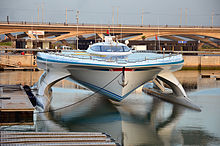
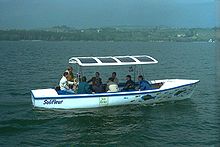
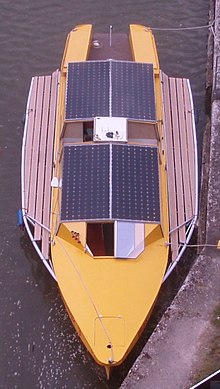
While a significant majority of water vessels are powered by diesel engines, with sail power and gasoline engines also remaining popular, boats powered by electricity have been used for over 120 years. Electric boats were very popular from the 1880s[1] until the 1920s, when the internal combustion engine took dominance. Since the energy crises of the 1970s, interest in this quiet and potentially renewable marine energy source has been increasing steadily again, especially as solar cells became available, for the first time making possible motorboats with an infinite range like sailboats. The first practical solar boat was probably constructed in 1975 in England.[2] The first electric sailboat which made a round-the-world tour, including the through the Panama Canal, with only green technologies is EcoSailingProject.
History
Early

An early electric boat was developed by the German inventor Moritz von Jacobi in 1839 in St Petersburg, Russia. It was a 24-foot (7.3 m) boat which carried 14 passengers at 3 miles per hour (4.8 km/h). It was successfully demonstrated to Emperor Nicholas I of Russia on the Neva River.
Golden Age
It took more than 30 years of battery and motor development before the electric boat became a practical proposition. This method of propulsion enjoyed something of a golden age from about 1880 to 1920, when gasoline-powered outboard motors became the dominant method.
Gustave Trouvé, French electrical engineer, patented a small electric motor in 1880. He initially suggested that the motor could power a set of paddle wheels to propel boats on the water, and later argued for the use of a propeller, instead.

An Austrian emigre to Britain, Anthony Reckenzaun, was instrumental in the development of the first practical electric boats. While working as an engineer for the Electrical Power Storage Company, he undertook much original and pioneering work on various forms of electric traction. In 1882 he designed the first significant electric launch driven by storage batteries, and named the boat Electricity.[3] The boat had a steel hull and was over 7 metres long. The batteries and electric equipment were concealed from view underneath the seating area, increasing the passenger accommodation. The boats were used for leisure excursions up and down the River Thames and provided a very smooth, clean and quiet trip. The boat could run for six hours and operate at an average speed of 8 miles per hour.[4]
Moritz Immisch established his company in 1882 in partnership with William Keppel, 7th Earl of Albemarle, specializing in the application of electric motors to transportation. The company employed Magnus Volk as a manager in the development of their electric launch department. After 12 months of experimental work starting in 1888 with a randan skiff, the firm commissioned the construction of hulls which they equipped with electrical apparatus. The world's first fleet of electric launches for hire, with a chain of electrical charging stations, was established along the River Thames in the 1880s. An 1893 pleasure map of the Thames shows 8 "charging stations for electric launches" between Kew (Strand-on-the-Green) and Reading (Caversham).[1] The company built its headquarters on the island called Platt's Eyot.
From 1889 until just before the First World War the boating season and regattas saw the silent electric boats plying their way up and downstream.[5]
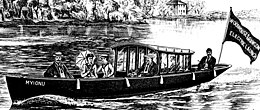
The company's electric launches were widely used by the rich as a conveyance along the river. Grand ships were constructed of teak or mahogany and furnished luxuriously, with stained glass windows, silk curtains and velvet cushions. William Sargeant was commissioned by Immisch's company to build the Mary Gordon in 1898 for Leeds City Council for use on the Roundhay Park Lake - the boat still survives and is currently being restored.[6] This 70 foot long luxury pleasure craft could carry up to 75 passengers in comfort. Launches were exported elsewhere - they were used in the Lake District and all over the world.
In the 1893 Chicago World Fair 55 launches developed from Anthony Reckenzaun's work carried more than a million passengers.[7][8] Electric boats had an early period of popularity between around 1890 and 1920, before the emergence of the internal combustion engine drove them out of most applications.
Most of the electric boats of this era were small passenger boats on non-tidal waters at a time when the only power alternative was steam.
Decline

With the advent of the gasoline-powered outboard motor, the use of electric power on boats declined from the 1920s. However, in a few situations, the use of electric boats has persisted from the early 20th century to the present day. One of these is on the Königssee lake, near Berchtesgaden in south-eastern Germany. Here the lake is considered so environmentally sensitive that steam and motor boats have been prohibited since 1909. Instead the Bayerische Seenschifffahrt company and its predecessors have operated a fleet of electric launches to provide a public passenger service on the lake.[9][10][11]
The first electrically powered submarines were built in the 1890s, such as the Spanish Peral submarine, launched in 1888.[12] Since then, electric power has been used almost exclusively for the powering of submarines underwater (traditionally by batteries), although diesel was used for directly powering the propeller while on the surface until the development of diesel-electric transmission by the US Navy in 1928, in which the propeller was always powered by an electric motor, energy coming from batteries while submerged or diesel generator while surfaced.
The use of combined fuel and electric propulsion (combined diesel-electric or gas, or CODLOG) has gradually been extended over the years to the extent that some modern liners such as the Queen Mary 2 use only electric motors for the actual propulsion, powered by diesel and gas turbine engines. The advantages include being able to run the fuel engines at an optimal speed at all times and being able to mount the electric motor in a pod which may be rotated by 360° for increased manoeuvrability. Note that this is not actually an electric boat, but rather a variant of diesel-electric or turbine-electric propulsion, similar to the diesel or electric propulsion used on submarines since WWI.
Renaissance
The use of electricity alone to power boats stagnated apart from their outboard use as trolling motors until the Duffy Electric Boat Company of California started mass-producing small electric craft in 1968. Duffy Boats has produced over 10,000 electric powered boats to date and is producing well over 300 per year today. It wasn't until 1982 that the Electric Boat Association was formed and solar powered boats started to emerge. A full chronicle of the above events will be published in Kevin Desmond's "The Electric Boat and Ship" to be published by McFarland in September 2017.
Components
The main components of the drive system of any electrically powered boat are similar in all cases, and similar to the options available for any electric vehicle.
Charger
Electric energy has to be obtained for the battery bank from some source.

- A mains charger allows the boat to be charged from shore-side power when available. Shore-based power stations are subject to much stricter environmental controls than the average marine diesel or outboard motor. By purchasing green electricity it is possible to operate electric boats using sustainable or renewable energy.
- Solar panels can be built into the boat in reasonable areas in the deck, cabin roof or as awnings. Some solar panels, or photovoltaic arrays, can be flexible enough to fit to slightly curved surfaces and can be ordered in unusual shapes and sizes. Nonetheless, the heavier, rigid mono-crystalline types are more efficient in terms of energy output per square meter. The efficiency of solar panels rapidly decreases when they are not pointed directly at the sun, so some way of tilting the arrays while under way is very advantageous.
- Towed generators are common on long-distance cruising yachts and can generate a lot of power when travelling under sail. If an electric boat has sails as well, and will be used in deep water (deeper than about 15 m or 50 ft), then a towed generator can help build up battery charge while sailing (there is no point in trailing such a generator while under electric propulsion as the extra drag from the generator would waste more electricity than it generates). Some electric power systems use the free-wheeling drive propeller to generate charge through the drive motor when sailing, but this system, including the design of the propeller and any gearing, cannot be optimised for both functions. It may be better locked off or feathered while the towed generator's more efficient turbine gathers energy.
- Wind turbines are common on cruising yachts and can be very well suited to electric boats. There are safety considerations regarding the spinning blades, especially in a strong wind. It is important that the boat is big enough that the turbine can be mounted out of the way of all passengers and crew under all circumstances, including when alongside a dock, a bank or a pier. It is also important that the boat is big enough and stable enough that the top hamper created by the turbine on its pole or mast does not compromise its stability in a strong wind or gale. Large enough wind generators could produce a completely wind-powered electric boat. No such boats are yet known although a few mechanical wind turbine powered boats exist.
- In hybrid electric boats, if a boat has an internal combustion engine anyway, then its alternator will provide significant charge when it is running. Two schemes are in use: the combustion engine and the electric motor are both coupled to the drive (parallel hybrid), or the combustion engine drives a generator only for charging the storage batteries (series hybrid).
In all cases, a charge regulator is needed. This ensures that the batteries are charged at their maximum safe rate when power is available, without overheating or internal damage, and that they are not overcharged when nearing full charge.
Battery bank
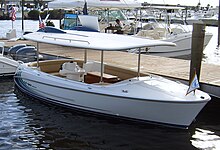
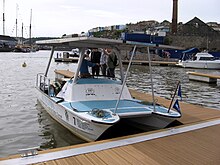
There have been significant technical advances in battery technology in recent years, and more are to be expected in the future.
- Lead–acid batteries were still the most viable option until the advent of larger, lithium-ion batteries mass-produced for electric cars from approximately c2012 onwards. Deep-cycle, 'traction' batteries are the obvious choice. They are heavy and bulky, but not much more so than the diesel engine, tanks and fittings that they may replace. They need to be securely mounted, low down and centrally situated in the boat. It is essential that they cannot move around under any circumstances. Care must be taken that there is no risk of the strong acid being spilled in the event of a capsize as this could be very dangerous. Venting of explosive hydrogen and oxygen gases is also necessary. Typical lead-acid batteries must be kept topped-up with distilled water.
- Valve-regulated lead-acid batteries (VRLA), usually known as sealed lead-acid, gel, or AGM batteries, minimize the risk of spillage, and gases are only vented when the batteries are overcharged. These batteries require minimal maintenance, as they cannot and usually do not need to be refilled with water.
- Nickel metal hydride, lithium-ion and other battery types are becoming available, but are still expensive. These are the kind of batteries currently common in rechargeable hand tools like drills and screwdrivers, but they are relatively new to this environment. They require different charge controllers to those that suit lead-acid types.
- Lithium-ion in this case usually means lithium iron phosphate batteries, which although are heavier than other lithium-ion, is safer for marine application. They are expensive but in applications which need reliability and ruggedness like ferries which run most of the day (10–12 hours/day) this is the best option. It has a much longer life - 5 to 7 years life-cycle.
- Fuel cells or flow batteries may provide significant advantages in years to come. Today (2017) however they are still expensive and require specialist equipment and knowledge.
The size of the battery bank determines the range of the boat under electric power. The speed at which the boat is motored also affects range – a lower speed can make a big difference to the energy required to move a hull. Other factors that affect range include sea-state, currents, windage and any charge that can be reclaimed while under way, for example by solar panels in full sun. A wind turbine in a good wind will help, and motor-sailing in any wind could do so even more.
Speed controller
To make the boat usable and maneuverable, a simple-to-operate forward/stop/backwards speed controller is needed. This must be efficient—i.e. it must not get hot and waste energy at any speed—and it must be able to stand the full current that could conceivably flow under any full-load condition. One of the most common types of speed controllers uses pulse-width modulation (PWM). PWM controllers send high frequency pulses of power to the motor(s). As more power is needed the pulses become longer in duration.
Electric motor
A wide variety of electric motor technologies are in use. Traditional field-wound DC motors were and still are used. Today many boats use lightweight permanent magnet DC motors. The advantage of both types is that while the speed can be controlled electronically, this is not a requirement. Some boats use AC motors or permanent magnet brushless motors. The advantages of these are the lack of commutators which can wear out or fail and the often lower currents allowing thinner cables; the disadvantages are the total reliance on the required electronic controllers and the usually high voltages which require a high standard of insulation.

Drive train
Traditional boats use an inboard motor powering a propeller through a propeller shaft complete with bearings and seals. Often a gear reduction is incorporated in order to be able to use a larger more efficient propeller. This can be a traditional gear box, coaxial planetary gears or a transmission with belts or chains. Because of the inevitable loss associated with gearing, many drives eliminate it by using slow high-torque motors. The electric motor can be encapsulated into a pod with the propeller and fixed outside the hull (saildrive) or on an outboard fixture (outboard motor).
Types
There are as many types of electric boat as there are boats with any other method of propulsion, but some types are significant for various reasons.

- Historical and restored electric boats, such as the Mary Gordon Electric Boat, exist and are often important projects for those involved.

- Canal, river and lake boats. Electric boats, with their limited range and performance, have tended to be used mostly on inland waterways, where their complete lack of local pollution is a significant advantage. Electric drives are also available as auxiliary propulsion for sailing yachts on inland waters.
- Electric outboards and trolling motors have been available for some years at prices from about $100 (US) up to several thousand. These require external batteries in the bottom of the boat, but are otherwise practical one-piece items. Most available electric outboards are not as efficient as custom drives, but are optimised for their intended use, e.g. for inland waterway fishermen. They are quiet and they do not pollute the water or the air, so they do not scare away or harm fish, birds and other wildlife. Combined with modern waterproof battery packs, electric outboards are also ideal for yacht tenders and other inshore pleasure boats.
- Cruising yachts usually have an auxiliary engine, and there are two main uses for it: One is to power ahead or motor-sail at sea when the wind is light or from the wrong direction. The other is to provide the last 10 minutes or so of propulsion when the boat is in port and needs to be manoeuvred into a tight berth in a crowded and confined marina or harbour. Electric propulsion is not suitable for prolonged cruising at full power although the power required to motor slowly in light airs and calm seas is small. Regarding the second case, electric drives are ideally suited as they can be finely controlled and can provide substantial power for short periods of time.

| Official videos for Ampere | |
|---|---|
- Commercial ferries. Norway's first battery-electric ferry is the Ampere,[13][14][15] with capacity for 120 cars and 12 trucks. As of November 2016[update], it has operated for 106,000 km. Its battery holds 1 MWh of energy, but the 9 minute charge time is sometimes not enough, and more battery capacity is to be installed. Norway has scheduled several other electric and hybrid ferry projects.[16] Based on operational data, Siemens concludes in a life cycle analysis that 61 of Norway's 112 diesel ferry routes could be replaced by electric ferries with a payback time of 5 years. The analysis includes auxiliary costs such as chargers, grid, and so on.[17]
- In Finland Föri, the historic Turku city ferry across the Aura River to Abo, was converted to all-electric propulsion in April 2017. The vessel was introduced as a wood-burning steam ferry in 1904, converted to diesel operation in 1955 and now provides a continuous daily service from 0615 to late evening for foot and cycle passengers on battery power. Charging takes place at night.[18]
- Other projects are considered in Canada, Sweden and Denmark.[19][20][21] India's First Solar Ferry, a 75-passenger boat, that is powered by sun and grid charging with lithium batteries, is under construction and expected to be in operation by July, 2016. Based on the predictions of consumption the payback time is 3 years.[22][23][24]
- Diesel-electric hybrid: There is a third potential use for a diesel auxiliary and that is to charge the batteries, when they suddenly start to wane far from shore in the middle of the night, or at anchor after some days of living aboard. In this case, where this kind of use is to be expected, perhaps on a larger cruising yacht, then a combined diesel-electric solution may be designed from the start. The diesel engine is installed with the prime purpose of charging the battery banks, and the electric motor with that of propulsion. There is some reduction in efficiency if motoring for long distances as the diesel's power is converted first to electricity and then to motion, but there is a balancing saving every time the wind-, sail- and solar-charged batteries are used for manoeuvring and for short journeys without starting the diesel. There is the flexibility of being able to start the diesel as a pure generator whenever required. The main losses are in weight and installation cost, but on the bigger cruising boats that may sit at anchor running large diesels for hours every day, these are not too big an issue, compared to the savings that can be made at other times. An example is the fishing boat Selfa El-Max 1099,[25] with 135 kWh battery and 80 kW diesel generator.[26] An LNG-powered supply vessel started operation in 2016 with a 653 kWh/1600 kW battery acting as spinning reserve during dynamic positioning, saving 15-30% fuel.[27]
- Solar powered: A boat propelled by direct solar energy is a marine solar vehicle. The available sunlight is almost always converted to electricity by solar cells, temporarily stored in accumulator batteries, and used to drive a propeller through an electric motor. Power levels are usually on the order of a few hundred watts to a few kilowatts. Solar powered boats started to become known around 1985 and in 1995 the first commercial solar passenger boats appeared.[28] Solar powered boats have been used successfully at sea. The first crossing of the Atlantic Ocean was achieved in the winter of 2006/2007 by the solar catamaran Sun21.[29][30] (see also List of solar-powered boats)
Wired electric boats

A special category of electric boats are the vessels receiving their electrical power by wire. This may involve overhead wires, where one or two wires are fixed over the water and the boat can make contact with them to draw electric current, or a waterproof tether cable may be used to connect the boat to shore. In case of a single overhead wire the electrical circuit has to be closed by the water itself, giving rise to a larger resistance and corrosion of the electrodes. In case of two wires no electric current has to be sent through the water, but the twin wires, which cause a short-circuit whenever they come into contact with each other, complicate the construction.
Naturally the boat has to stay close to the wire, or its tether point, and therefore it is limited in its maneuverability. For ferries and on narrow canals this is no problem. The Straussee Ferry in Strausberg, Germany is an example. It crosses a lake along a 370 m trajectory and is powered by 170 V from a single overhead wire. The Kastelletleden ferry crosses a 200 metres (660 ft) wide shipping channel in Sweden, using a submergable tethered supply cable which is lowered to the sea-bed when the ferry is docked at the opposite terminal to its tethering point.
In the Mauvages tunnel on the Marne-Rhine Canal a bipolar overhead line provides 600 V DC to an electrical tug, pulling itself and several ships through the 4877 m tunnel along a submerged chain. This prevents the buildup of diesel exhaust fumes in the tunnel. Another example was the experimental electrical tug Teltow on the Kleinmachnower See, 17 km south-west of Berlin. It was used from 1903 till 1910 and had current collection poles based on those used on trolley buses.
Pollution and embodied energy
All the component parts of any boat have to be manufactured and will eventually have to be disposed of. Some pollution and use of other energy sources are inevitable during these stages of the boat's life and electric boats are no exception. The benefits to the global environment that are achieved by the use of electric propulsion are manifested during the working life of the boat, which can be many years. These benefits are also most directly felt in the sensitive and very beautiful environments in which such a boat is used.
The May 2010 edition of Classic Boat magazine carried a pro and con article entitled Electric debate.[31] Jamie Campbell argued against electric boating on four main counts, which were rebuffed by Kevin Desmond and Ian Rutter of the Electric Boat Association. Jamie Campbell asserted that electric propulsion can no more be justified afloat than a Seagull outboard motor, proposing wooden sailing boats and rowing dinghies as "by far the most environmentally sensitive and renewable options for recreational boating".
- Electricity production
- Campbell asserts that the lack of pollution from an electric boat "reeks of nimbyism" as "the discharge is all in someone else's back yard" and that the provision of re-charging points may involve digging up miles of habitat. Desmond responds that while there is no doubt that rechargeable batteries derive their energy from power stations (when not charged on board by solar and wind generation), noisier internal-combustion-engined boats obtain their fuel from even further away and that, once installed a power cable is less environmentally disruptive than a petrol station. Rutter notes that electric boats tend to recharge overnight, using 'base load'.
- Efficiency
- While there are losses in the charge/discharge cycle and in the conversion of electricity to motive power, Rutter points out that most electric boats need only about 1.5 kW or 2 hp to cruise at 5 mph, a common maximum river speed and that a 30 hp petrol or diesel engine producing only 2 hp is considerably more inefficient. While Campbell refers to heavy batteries requiring a "load-bearing hull" and "cranky, even unseaworthy vessels", Desmond points out that electric boaters tend to prefer efficient, low-wash hull forms that are more friendly to river banks.
- Pollution
- Campbell discusses the pollution that "traditional" batteries put into the water when a boat sinks, but Desmond says that electric boats are no more liable to sinking than other types and lists the leakage of fuel, engine oil and coolant additives as inevitable when an internal-combustion-engined boat sinks. Rutter points to the "very nasty cocktail of pollutants" that come out of a diesel wet exhaust in normal use.
- Battery manufacture
- Campbell mentions "all manner of noxious chemicals ... involved in battery manufacture", but Rutter describes them as being "lead and sulphuric acid with a few extra trace metals in a modest plastic box" with a potential lifetime of 10–12 years. Desmond says that the US has a 98% recycling rate for lead acid batteries and that the battery and lead-smelting industries observe some of the tightest pollution control standards in the world.
The article mentions 25% and 30% discounts being offered to electric boaters by the UK Environment Agency and the Broads Authority and that battery powered vehicles have 3⁄5 the carbon footprint of their petrol equivalents. It is claimed that a typical recharge after a day's cruising costs £1.50, without the use of solar or wind power.[31]
A 2016 life-cycle study in Norway states that electric ferries and hybrid offshore supply ships compensate for the environmental effects of producing lithium-ion batteries in less than 2 months.[32]
Solar ships
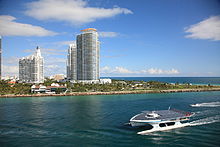
In 2010, the Tûranor PlanetSolar, a 35 metre long, 26 metre wide catamaran yacht powered by 537 square metres of solar panels, was unveiled. On 4 May 2012 it completed a 60,023 kilometres (37,297 mi) circumnavigation of the Earth in Monaco after 585 days and visiting 28 different countries, without using any fossil fuel. It is so far the largest solar-powered boat ever built.[33]
India's first solar ferry, a 75-passenger boat fully powered by sun, is under construction. It is expected to be completed by the middle of 2016.[22]
Japan's biggest shipping line Nippon Yusen and Nippon Oil Corporation said solar panels capable of generating 40 kilowatts of electricity would be placed on top of a 60,000 tonne car carrier ship to be used by Toyota Motor Corporation.[34][35][36]
The Monaco yacht company Wally has announced a "gigayacht" designed for billionaires torn between buying a mansion and a superyacht.[37] The Why 58 x 38 is designed to have an autonomous cruising range of 12,000 miles at 12 knots by means of 900m2 of solar panels which generate 150 kW to assist the diesel-electric motors and optional Skysails.[38]
See also
- Trolley boat
- Battery (electricity)
- Cruising
- Diesel-electric
- Electric outboard motor
- Electric vehicle
- Frisian Solar Challenge
- Integrated electric propulsion
- Lloyd's Register
- Oceanvolt
- Renewable energy
- Solar Splash
References
- ^ a b The Oarsman's and Angler's Map of the River Thames from its source to London Bridge (1991. Old House Books, Devon ed.). James Reynolds & Son, London. 1893.
- ^ Electrical Review Vol 201 No 7 12 August 1977
- ^ Illustrated with wood engravings in the Electrical Review, Vol.XI, No.255, 14 October 1882, pp.296 and 297
- ^ "Batteries". Mary Gordon Trust. Archived from the original on 6 June 2014.
{{cite web}}: Unknown parameter|deadurl=ignored (|url-status=suggested) (help) - ^ 'Electric Boats on the Thames 1889-1914' by Edward Hawthorne, 1995 Alan Sutton Publishing Ltd; ISBN 0-7509-1015-1 : many references to Moritz Immisch's pioneering work with electric boats on pages 14-29; pages 30-40; pages 149-150, 166-169, and certain other pages
- ^ "Mary Gordon Electric River Boat". Archived from the original on 7 June 2010. Retrieved 31 May 2010.
{{cite web}}: Unknown parameter|deadurl=ignored (|url-status=suggested) (help) - ^ "The story of solar powered boats". Retrieved 31 May 2010.
- ^ "History of our Classic Motor Yachts". Elco. Retrieved 21 February 2011.
- ^ "Bayerische Seenschifffahrt GmbH" (in German). Bavarian State Ministry of the Interior. Archived from the original on 29 September 2011. Retrieved 11 July 2011.
{{cite web}}: Unknown parameter|deadurl=ignored (|url-status=suggested) (help); Unknown parameter|trans_title=ignored (|trans-title=suggested) (help) - ^ "Geschichtliche Hintergründe" (in German). Bayerische Seenschifffahrt. Archived from the original on 10 December 2011. Retrieved 11 July 2011.
{{cite web}}: Unknown parameter|deadurl=ignored (|url-status=suggested) (help); Unknown parameter|trans_title=ignored (|trans-title=suggested) (help) - ^ Quiet Cruising on Königssee Archive
- ^ "General Dynamics Corporation", Encyclopædia Britannica (15th ed.), 1993
- ^ Stensvold, Tore. "Denne fergen er revolusjonerende. Men passasjerene merker det knapt" Teknisk Ukeblad, 20 March 2015.
- ^ Stensvold, Tore. "Nå lader batterifergen mer enn hun trenger" Teknisk Ukeblad, 13 May 2015.
- ^ Setting a Course for Carbon-Free Shipping 2014 archive. Video on YouTube
- ^ "Batterifergen har måttet stå over avganger. Nå er løsningen klar". Teknisk Ukeblad. Retrieved 19 November 2016.
- ^ Stensvold, Tore. "Lønnsomt å bytte ut 70 prosent av fergene med batteri- eller hybridferger" Teknisk Ukeblad, 14. August 2015. In English
- ^ "Historic Turku ferry converted to all-electric operation". Marine Log. New York: Simmons-Boardman Publishing Inc. 28 April 2017. ISSN 2166-210X.
- ^ Electric ferry jolts discussion over powering ships in B.C. Vancouver Sun
- ^ Sweden launches world's first quick-charging electric passenger ferry GizMag
- ^ Electric drive train by Visedo to equip world’s largest electric ferry
- ^ a b "India's First 75-Seater Solar Ferry Readies To Test The Waters". OfficeChai. Retrieved 4 February 2016.
- ^ "India's first solar ferry for Alappuzha". The Hindu. 3 March 2016. ISSN 0971-751X. Retrieved 24 May 2016.
- ^ "Kerala Govt. Commissions India's First Solar-Powered Boat, Paves the Way for a Greener Tomorrow". The Better India. 11 May 2016. Retrieved 24 May 2016.
- ^ Valle, Marius. "Dette er Norges første fiskebåt med elmotor" Teknisk Ukeblad, 31 July 2015.
- ^ "Batterifiskebåten Karoline: Ett år uten driftsavbrudd". Teknisk Ukeblad. Retrieved 22 August 2016.
- ^ "Første i verden: Her skal batterier erstatte motor i kritiske situasjoner". Teknisk Ukeblad. Retrieved 11 October 2016.
batteripakken ombord på Viking Energy erstatter en hovedmotor som reserve (spinning reserve)
- ^ "Solarschiffe für die Expo?". Umwelteinsatz.ch. Retrieved 20 June 2009.
- ^ "The world's first crossing of the Atlantic on a solar boat". transatlantic21. Retrieved 20 June 2009.
- ^ "EERE News: EERE Network News - 06 December 2006". Apps1.eere.energy.gov. 6 December 2006. Retrieved 20 June 2009.
- ^ a b Campbell, Jamie; Kevin Desmond; Ian Rutter (May 2010). "Electric debate". Classic Boat (263). Croydon, England: IPC Media: 48–49. ISSN 0950-3315. Retrieved 13 April 2010.
- ^ "Batterier til elferger: Miljøbelastningen er spart inn etter 1,4 måneder". Teknisk Ukeblad. Retrieved 10 January 2017.
- ^ Raphael Domjan the Swiss ecoexplorer was the founder and the expedition leader of the project PlanetSolar. "MS Tûranor PlanetSolar yacht completes her first tour around the world with a success". Charterworld.com. 4 May 2012. Retrieved 9 May 2012.
- ^ "Alternative Energy and Fuel News: ENN - Know Your Environment". ENN. 26 August 2008. Retrieved 20 June 2009.
- ^ "Japan launches first solar cargo ship". Solardaily.com. Retrieved 20 June 2009.
- ^ "Solar ship sails the ocean green - National". www.smh.com.au. 15 March 2005. Retrieved 20 June 2009.
- ^ "The world's first gigayacht". Motor Boat Monthly. 11 June 2010.
- ^ "Why". Wally Yachts. Archived from the original on 2 April 2010. Retrieved 11 June 2010.
{{cite web}}: Unknown parameter|deadurl=ignored (|url-status=suggested) (help)
External links
- Electric Boat Design
- Electric passenger Boat Designed for the city of Bordeaux (France)
- Electric Boat Association (UK nonprofit)
- Electric Boat Association (Australia nonprofit)
- Electric Boat Association (US nonprofit)
- Electric Seas Organization (US nonprofit)
- Project of making of 10 Passenger Solar Boat
- Solar powered vessels
